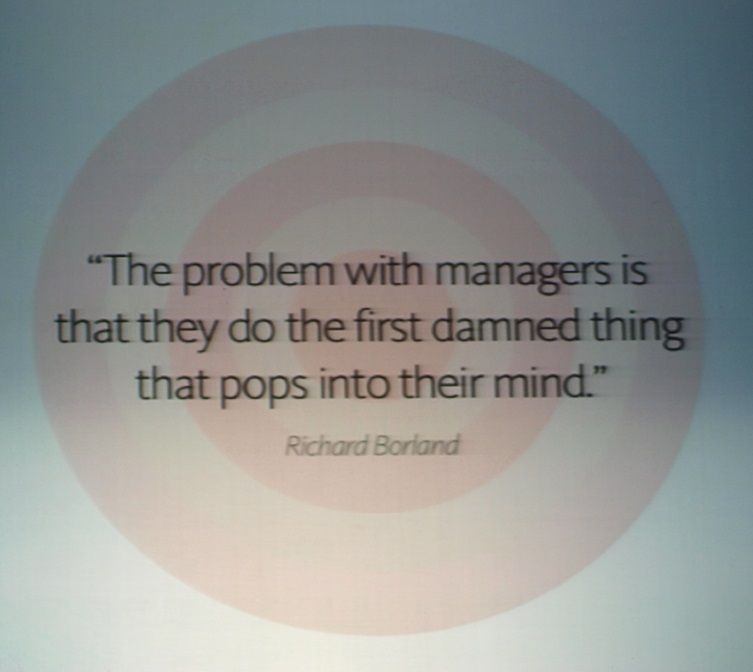Systems Thinking &
The Supply Chain
"We supply chain managers maintain and feed a conceit that we understand and employ systems thinking in the execution of our duties."

In August 2013, Supply Chain Digest ran an article of mine in the “First Thoughts” section. Actually, it was two articles, a Part 1 and a Part 2. SC Digest editor Dan Gilmore runs what is one of the more thoughtful resources about supply chain management. Every year when he takes his summer vacation, he offers the space in his weekly column to a writer he thinks will do something with a topic. I have been blessed with that honor three of the past four years.
Dan likes my material. He says I am not shy about "mixing it up and being provocative" with my opinions. Perhaps he should not have told me that, because that just encourages me. So I wrote an article titled, “Systems Thinking in the Supply Chain,” which Dan ran the first two weeks of August. Dan is a very good editor who knows his audience, but perhaps the introduction was a bit more hardcore than he liked. For fun, and to stir things up, here is the original version of the article, with the graphics that I submitted. Please enjoy.
~
We supply chain managers maintain and feed a conceit that we understand and employ systems thinking in the execution of our duties. That is an excessively favorable opinion of our own abilities and actions. The idea that as a class of managers, we use systems thinking in the planning and execution of supply chain management is somewhat imaginary, conceived in our own minds, perhaps farfetched.
If, after reading that opening volley you are confused, perhaps you should consider the definition of the words conceit and systems thinking.
Let’s start with systems thinking first. It is an approach to problem solving that looks at the problems as part of a system. When working with an organizational structure, like a supply chain, the system is the combination of the people, structures, processes, and environment that work together (or don’t work together) to create a desired outcome. A healthy system delivers the desired outcome. An unhealthy system delivers unintended consequences.
Now go read the first paragraph again. That is the definition of conceit.
The first paragraph could make you angry. You may think that it is, at best, an inaccurate statement. If so, go watch the receiving dock of any large distribution center and ask yourself, how much systems thinking did the companies shipping into this operation employ?
Granted, there are very good logistics operations that operate today. You may work in one of them. The larger retailers, larger consumer products companies, and the larger manufacturers build solid logistics systems. The best of supply chains are well known examples of systems thinking. You know the names: Dell, Ford, Proctor & Gamble, Apple, McDonald’s, Amazon, Unilever, Intel, and more. Go look at the Gartner Top-25 supply-chain list and you will find 25 examples of excellent systems thinking.
I agree that these are the cream of supply chain performance. However, as the cream, they represent a small group of star performers. How much cream is there? Who knows – but if we apply the ratio of cream to cow’s milk, a pint per gallon, then about 12 percent of the corporate supply chains are the cream. If we apply the cream logic, only 12 percent of the supply chains apply systems thinking to their supply chain. That leaves 88 percent of the supply chains that may not apply systems thinking processes.
Following the logic of Garrison Keillor’s Lake Wobegon, "where all the women are strong, all the men are good-looking, and all the children are above average,” most supply chain managers would like to think that they employ systems thinking. The sad truth is, they don’t. I have seen many examples of a lack of systems thinking in over 28 years in this business. While I do believe that there is a small core of real systems thinkers in supply chain management, I also believe there are far more managers who would like to believe they approach their supply chains using systems thinking to solve problems. Therefore, I stand by my opening statement.
Do You Need More Evidence?
Anybody out there remember the last time they drew a causal diagram?
If I use the cream logic, about 12 percent of the readers here remember the last time they did. Let’s get more selective. Has anybody used a causal diagram in the past month? How about the past week?
Who can tell me what a causal diagram is? Anybody?
We live in a complex environment, surrounded by complex systems of people, things, and actions. Most activities, even when they look simple on the surface, can be very complex under the covers. Our ability to visualize the components of a system, the interaction between the components, and understand the outside influences on the system directly affects our ability to understand the complexity of that system. Visualization is key to cognitive ability; the ability to understand what is going on.
I learned a long time ago that it is hard to think about something that is complex without drawing a picture of it. I know I am not alone in this discovery. We use white boards, flip charts, chalkboards, paper, and bar napkins to get our ideas across to people, and to work out ideas with ourselves.
So, let me ask a different question: How many of you in the past day used some sort of drawing to help you think? I bet most of you say yes. But was it a causal diagram?
As supply chain managers, we like to talk about getting to the root cause of a problem, not treating the symptom, but fixing the cause first because that fixes the problem for good. In fact, many of us are proud of our desire to get to the root cause. However, if you look at the way problems get solved in the supply chain, we are not as successful as we could be.
There is a reason for our lack of success. We don’t draw enough causal diagrams of the systems we work in. Without drawing a causal diagram, we have a hard time visualizing the relationships between the variables in our system. Without the diagram, the drawing, we limit our visualization to the words we use, our verbal skills. I know I have a good vocabulary and am able to write and speak with sufficient skill. Still, it does not matter how good I am if the people I am working with don’t know my language. If they don’t understand the terms, or can’t understand the relationships I see, I am going to have a hard time expressing my ideas in a way they can understand.
The tool I use is a causal diagram. I am not the only person who uses causal diagrams. For over 50 years, people have used causal diagrams to help define complex systems in every profession. You could say that causal diagrams are the heart of systems thinking.

The best way to illustrate is to illustrate.
This diagram is straight out of APICS. It is a systems model that focuses on new product development, illustrating the complexity of a single supply chain. As complex as it looks, this is really a basic, simple model.
There are only ten nodes of influence, and only five cycles.
I would bet that some of us live with supply chains far more complex than this. Still, this is a complete and concise starting point that covers the primary components of any supply chain.
The Engine – the Reinforcing System
The core of the model is the New Product Growth. This loop is a reinforcing loop, in which each cycle of the loop reinforces the action, like a snowball rolling down a hillside. Without friction and with no end to hill or snow, the snowball builds in size and momentum. Demand influences the Need for Supply, influencing the Sources for Supply, influencing the Inventory, influencing Price, which influences Demand. Without any other outside influences, Demand will drive more supply, building more inventory and lower prices, driving more demand.
Brakes and Controls — the Balancing Systems
Surrounding the core engine of this supply chain system are four interdependent systems. Each of these systems influences the core from the outside, slowing it down and influencing the growth. Think about our snowball rolling down the hill. If the snow is light and dry, the snowball can’t pick up as much weight as it rolls down. The light snow creates rolling resistance. The wind can push the ball off course. The snow can run out, or the hill stop. Our kid brother can step in front of the ball and stop it.
Each of the balancing systems in our chart above will slow down the speed of our New Product Growth. Longer transportation distances increase the transportation cost and the lead-time. Longer distances also increase risk of disruption. A longer lead-time can affect the inventory we need, indirectly, as supply chain vulnerability increases.
As the conditions of each of these influencing factors changes, the resistance that each of the balancing systems places on the engine changes.
Simple, Inaccurate, and Incomplete
As I pointed out, this diagram is basic and simple. It is also incomplete and inaccurate.
Addressing incomplete first, the financial aspects of the supply chain are missing. There is no system depicting the available working capital or cash-to-cash cycle. That is no surprise, since so many supply chain managers lack a solid understanding of the complex financial processes behind the supply chain. The model also fails to recognize other influences on demand, such as promotion or competition. Specific to competition, the system is not just the competition from a competing supply chain (competitive company). Competition can be in the form of a substitute product that does the same job.
Imagine the local fast food row close to where you work. Not only is there market competition for fast and tasty vittles offered by different restaurants, there are complete substitutions, like a brown bag lunch, the snack machine, or the internal cafeteria. This model does not touch on the power of the substituted product or service.
Now I will address the inaccurate claim. The lead-time loop is in the wrong place. While transportation influences lead-time, demand really does not, and lead time my not influence the Need for Supply as much as it influences the decisions about the amount of inventory.
Cognitive Ability
Causal diagrams are fundamental tools that support systems thinking. They are not the only tool, and by far are not the end all, be all of understanding complex systems. But they are an important tool that all supply chain managers should have in their tool boxes.
 One of my colleagues talks about the cognitive ability of managers to see and understand the inherent complexity of the supply chain. He talks about the required wetware (I call it meatware) to see, think, and talk about the complexities of the different influences. I don’t think that our cognitive ability is at fault; it is more of an issue of our will to use our cognitive skills to think of the systems. Systems thinking is not a new practice. Professor Jay Forrester started teaching system dynamics in the mid 1950s at MIT’s Slone Business School.
One of my colleagues talks about the cognitive ability of managers to see and understand the inherent complexity of the supply chain. He talks about the required wetware (I call it meatware) to see, think, and talk about the complexities of the different influences. I don’t think that our cognitive ability is at fault; it is more of an issue of our will to use our cognitive skills to think of the systems. Systems thinking is not a new practice. Professor Jay Forrester started teaching system dynamics in the mid 1950s at MIT’s Slone Business School.
It is not an issue of ability; it is an issue of awareness and willingness. Frankly, the problem with managers is that they do the first damned thing that pops into their mind. How many times have you, as a manager, in the last week, made a decision as a reaction? Of those instances, how many times did you do the first thing that you thought of?
This brings us full circle to my opening statement: We supply chain managers maintain and feed a conceit that we understand and employ systems thinking in the execution of our duties.
In most cases, we act based on our experience, not thinking of the other factors influencing the living system that we are managing a small part of. We influence only a portion of the system, so to think that we can through simple will and quick decision control and change other parts of the system is an excessively favorable opinion of our own abilities and actions. While able to employ systems thinking, do we choose to take the action to think?


